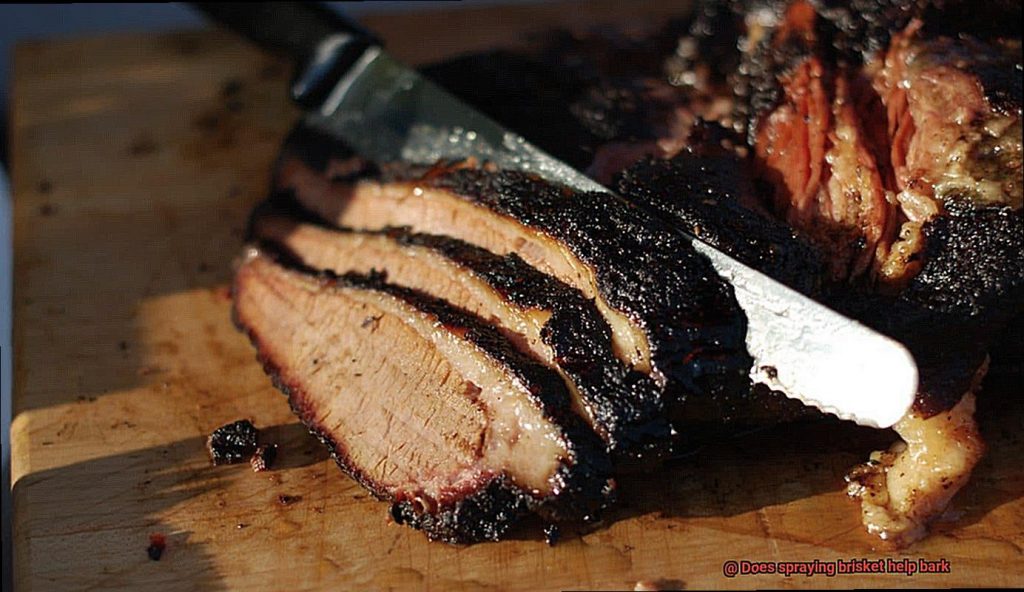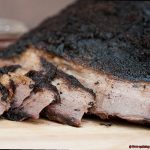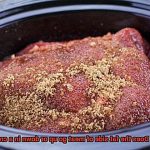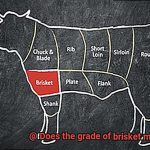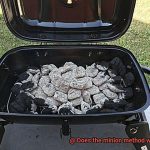Picture this: a mouth-watering, perfectly cooked brisket. The smoky aroma fills the air as you slice into the tender, juicy beef. But what about that crispy, crunchy bark on the outside? Can spraying your meat really help to achieve that coveted texture?
Many pitmasters swear by spritzing their briskets with flavorful liquids like apple juice or beer. They claim that the moisture from the spray creates steam, which breaks down tough muscle fibers and results in a more tender final product. But does this method actually improve the bark, or is it just an old wives’ tale?
In this blog post, we’ll delve deep into the science behind brisket bark. We’ll explore what makes it so delicious and how different cooking methods can affect its formation. We’ll also investigate the pros and cons of spritzing your brisket – weighing up both sides of this hotly debated topic.
By the end of this article, you’ll have all the knowledge you need to achieve that perfect bark – every time. So get ready to take your brisket game to new heights.
Contents
What is Brisket Bark?
If you’re a fan of smoked meat, then you know that the “bark” on a brisket is an essential element of the experience. But, what exactly is brisket bark, and how is it formed?
Brisket bark is the crispy, flavorful outer layer that forms on a smoked brisket. It’s a sought-after characteristic because it adds a unique texture and depth of flavor to the meat. The process of creating this crispy crust is complex but well worth the effort.
Firstly, a dry rub or marinade is used to season the meat. The rub should contain a mixture of salt, pepper, garlic, and other spices that complement the flavor of the meat. Once seasoned, the brisket is placed in a smoker and cooked at a low temperature for several hours.
As the meat cooks, smoke from wood chips permeates it, and the heat causes fat and connective tissue to break down, adding even more flavor and tenderness. The crust that forms on the surface of the meat is created by a process called the Maillard reaction. This reaction occurs when heat causes amino acids and sugars to react and form new compounds, creating a browned and crispy exterior that’s packed with flavor.
While some pitmasters swear by spraying their brisket with liquid during cooking to keep it moist, too much moisture can actually hinder the formation of good bark. The liquid can cool down the surface of the meat, preventing it from getting hot enough to form a proper crust. Additionally, too much liquid can wash away any rub or seasoning applied to the meat.
How Does Spraying Help Create a Better Bark?
Spraying involves applying a liquid solution to moisten the meat and help it form a more pronounced bark. This can be done with a variety of liquids such as water, apple cider vinegar, beer, or a combination of different liquids. The solution is applied using a spray bottle or mop every 30 minutes or so throughout the cooking process.
But why bother with spraying? For starters, it helps keep the surface of the meat moist, allowing for more smoke and flavor absorption. This moisture also breaks down tough fibers in the meat, resulting in a tender and juicy final product. Plus, spraying can regulate temperature by preventing the meat from drying out too quickly.
But perhaps one of the best benefits of spraying is creating an even bark on your brisket. By keeping the surface moist, the bark will form more evenly and prevent any areas from becoming overly charred or burnt. And let’s not forget about appearance – in competitions, a perfect bark is just as important as taste.
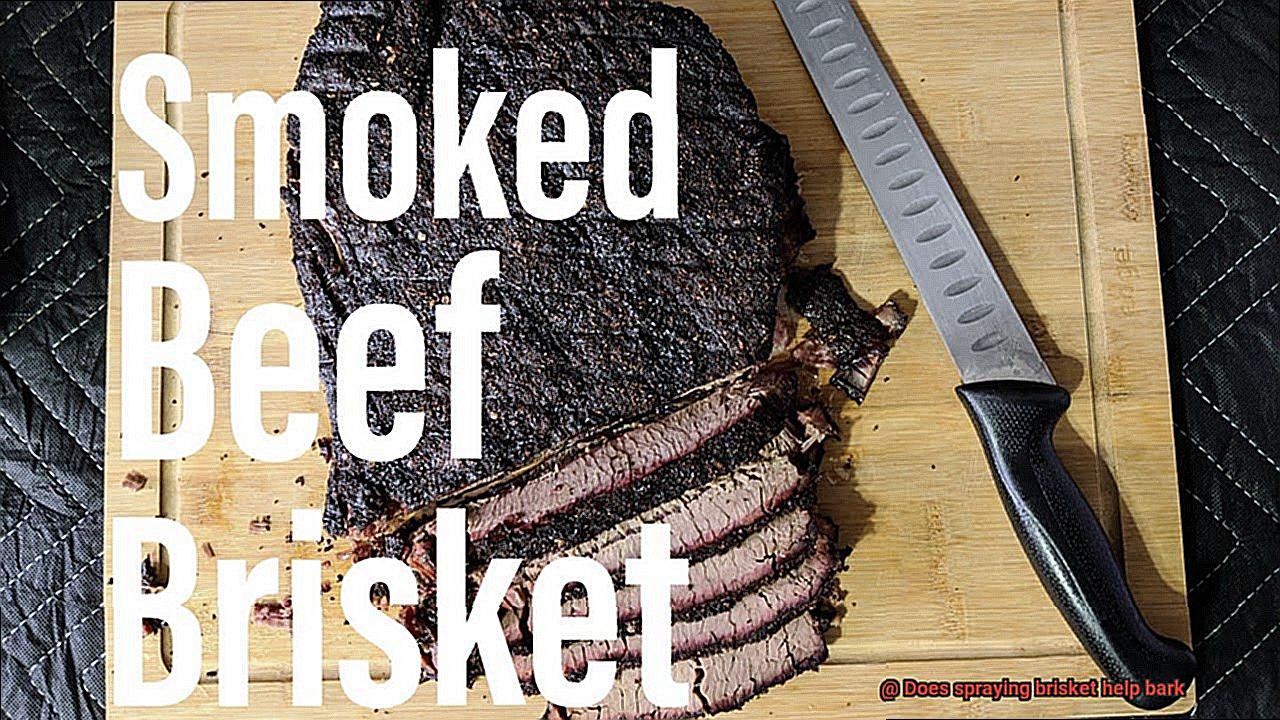
So, experiment with different liquids and techniques to find what works best for you and your recipe. Try using a spray bottle or mop every 30 minutes or so throughout the cooking process to keep the surface moist and create an even bark. With some practice and patience, you’ll be able to create a perfectly formed bark that will have everyone coming back for seconds.
Pros and Cons of Spraying Brisket
Many pitmasters swear by this technique, claiming it keeps the meat moist and adds flavor. However, there are also those who argue that it’s unnecessary and can even disrupt the cooking process. So, let’s explore the pros and cons of spraying brisket and discover if it’s worth the effort.
Firstly, let’s look at the pros. Spraying your brisket with a liquid during cooking can provide much-needed moisture, resulting in a more tender and juicy end result that melts in your mouth. Additionally, choosing liquids like apple juice or beer can enhance the overall taste with additional flavors. Appearance is also a benefit as a well-sprayed brisket can have a darker, richer color on the outside, making it look more appetizing and professional.
However, there are also some potential drawbacks to consider. One issue is interruption – opening your smoker or grill every time you spray can let out heat and smoke, disrupting the cooking process and making it harder to maintain consistent temperature and smoke levels. Inconsistency is another factor as spraying too much or too little can result in an uneven bark. Furthermore, some liquids like water can wash away rubs and seasonings from the surface of the meat.
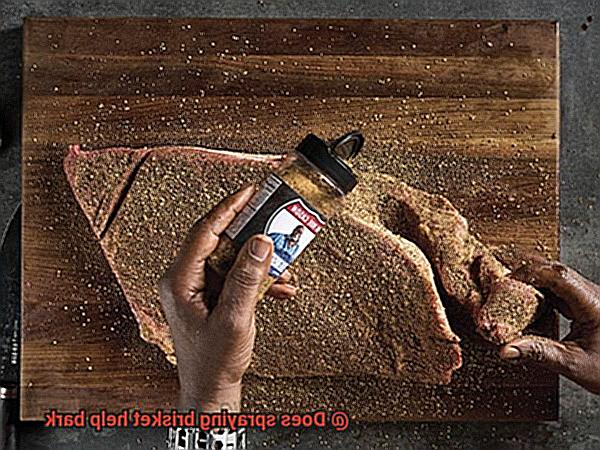
It’s important to note that opinions on whether or not spraying is necessary or beneficial are divided among pitmasters. Some believe a great bark can be achieved without any additional moisture while others swear by it. Ultimately, it comes down to personal preference and experimentation with different methods.
What Type of Liquid Should Be Used?
While the debate over whether to spray during cooking is ongoing, those who do opt for this method know how crucial it is to use the right liquid.
When it comes to selecting a liquid, there are several popular options to consider. Apple juice, vinegar, and water reign as the top choices, but don’t hesitate to experiment with other options like beer, bourbon, or even soda. The key is to find what works best for your taste buds and desired outcome.
If you’re looking for a sweet flavor and tender meat, apple juice is an excellent choice. This liquid helps caramelize the brisket’s surface while providing a subtle sweetness that will leave you craving more. To achieve optimal results, use fresh juice or 100% pure juice without any added sugars or preservatives.
On the other hand, if you’re aiming for a tangy flavor and crispy bark, try using vinegar. Popular options include apple cider vinegar or white distilled vinegar. Not only does vinegar help break down tough meat fibers, but its acidic properties also promote the formation of a crispy crust.
In a pinch, water is always an option. Although it won’t add any additional flavors or tenderize your meat, it will keep your brisket moist during cooking and prevent it from drying out.
Ultimately, the type of liquid you choose depends on personal preference and desired flavor profile. Don’t be afraid to experiment with different liquids until you find the perfect one for your brisket. Just remember to spray lightly and not too frequently so as not to wash away the rub and prevent your bark from forming properly.
When Should You Spray the Brisket?
One of the most hotly debated topics among pitmasters is when to spray the brisket to create a mouth-watering bark. Timing is everything, and as an expert in the field, I can guide you through this process.
First things first, choose the right liquid for your spray. Apple juice, vinegar, and water are popular choices that each offer unique benefits. Pick one that complements your desired flavor and texture.
When it comes to timing, most experts recommend waiting until after the first few hours of cooking when the bark has started to form. From there, you should be spraying your brisket every hour or so. However, keep in mind that every cut of meat is different and may require more or less frequent spraying depending on various factors such as size, fat content, and cooking environment.
Furthermore, it’s important to note that once your brisket reaches an internal temperature of around 170-180°F, you should stop spraying it. Any further moisture may disrupt the bark formation and cause it to become too soft or mushy.
Therefore, monitoring your brisket carefully is crucial. Adjust your spraying schedule as needed to achieve the perfect bark. With patience and attention to detail, you’ll be able to find the sweet spot for your particular cut of meat and cooking method.
Tips for Creating a Perfect Bark
Look no further than these tips and techniques for creating the perfect bark on your meat.
Use a Dry Rub
A dry rub is key to creating a flavorful and crispy bark. Opt for a blend of salt, pepper, and other spices of your choice to draw out moisture from the surface of the meat, creating a crusty texture. Allow the rub to sit on the meat for at least a few hours or overnight to maximize flavor.
Maintain Consistent Temperature
Temperature fluctuations can cause the bark to become too dark or not form properly. Use a reliable thermometer to monitor the temperature of your grill or smoker, and adjust as needed. This will ensure that your brisket cooks evenly and develops that signature smoky flavor.
Spritz with Liquid
Spraying your brisket with liquid during cooking can help keep the surface moist while also promoting the formation of a crispy bark. Some pitmasters swear by apple cider vinegar and water, which can help tenderize the meat while adding a tangy flavor. Others prefer water or apple juice. Experiment with different liquids to find what works best for you.
Cook Low and Slow
Low and slow is the name of the game when it comes to brisket. Aim for a cooking temperature of 225-250°F and plan for approximately 1-1.5 hours per pound of meat. This allows the flavors to develop and the bark to form properly, resulting in a tender and juicy brisket with a mouthwatering crust.
Resist Fiddling
It may be tempting to constantly check on your brisket, but resist the urge to fiddle with it too much during cooking. Opening and closing the smoker or grill too frequently can cause temperature fluctuations that prevent the bark from forming properly. Instead, let your brisket cook undisturbed for several hours at a time, only checking on it occasionally to ensure that it’s not drying out or burning.
The Role of Rubs and Seasonings in Bark Formation
Look no further than the world of rubs and seasonings, where the perfect blend of spices can create a mouthwatering bark on your meat.
Rubs are the foundation of creating a flavorful bark. A mixture of salt, sugar, and spices is applied to the meat before cooking. The salt draws out moisture from the surface, creating a dry environment that promotes bark formation. Meanwhile, sugar caramelizes during cooking, resulting in a crispy exterior. A combination of paprika, garlic powder, onion powder, cumin, and chili powder can create a complex flavor profile that complements the natural flavors of the meat.
But rubs alone won’t guarantee a perfect bark. Temperature and airflow are also essential. Spraying water or other liquids on the brisket can help create a humid environment that promotes bark formation. As the water evaporates during cooking, it creates steam that keeps the surface moist, promoting even cooking and a consistent bark throughout the entire brisket.
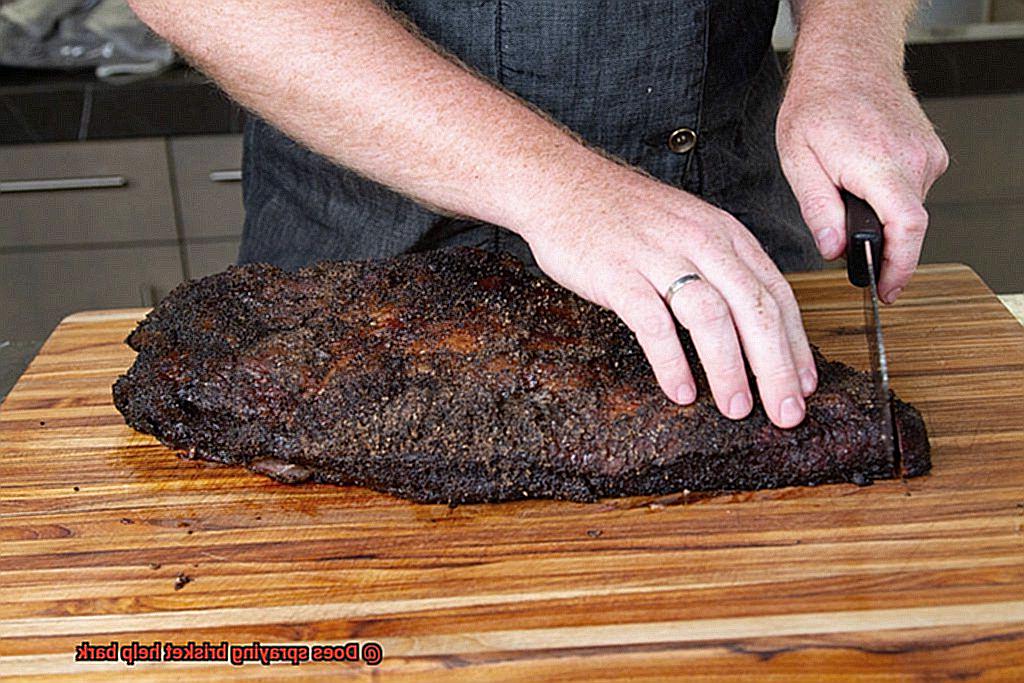
Here are some tips for creating the ultimate bark:
- Experiment with different rub blends to find your perfect combination.
- Apply the rub generously and evenly to ensure maximum flavor and bark formation.
- Use a water pan in your smoker to create a moist environment.
- Spritz the brisket with water or other liquids every 30 minutes to maintain moisture throughout cooking.
- Let the brisket rest for at least 30 minutes after cooking to allow the juices to redistribute and prevent moisture loss.
Y9PdiM2eAd4″ >
Conclusion
In summary, the age-old question of whether spraying brisket helps create a perfect bark remains a topic of debate. Nevertheless, many seasoned pitmasters swear by this technique, claiming that it keeps the meat moist and enhances its flavor.
Spraying involves applying a liquid solution to the meat to keep it moist and encourage the formation of a more pronounced bark. The choice of liquid used depends on personal preferences and desired flavor profiles, with popular options including apple juice, vinegar, and water.
Timing is crucial when it comes to spraying brisket for optimal bark formation. Experts recommend waiting until after the first few hours of cooking when the bark has started to form before spraying every hour or so throughout the cooking process.
While some argue that excessive moisture can hinder bark formation, others believe that spraying creates an even bark on your brisket. By keeping the surface of the meat moist, more smoke and flavor absorption can occur while regulating temperature by preventing the meat from drying out too quickly.
Ultimately, creating a perfect bark comes down to personal preference and experimentation with different methods.
Utilizing techniques such as maintaining consistent temperature, using a dry rub, cooking low and slow, resisting fiddling with your brisket too much during cooking time, experimenting with different liquids in spritzing your brisket every 30 minutes or so throughout the cooking process will help you achieve mouth-watering results that will have everyone coming back for seconds.

